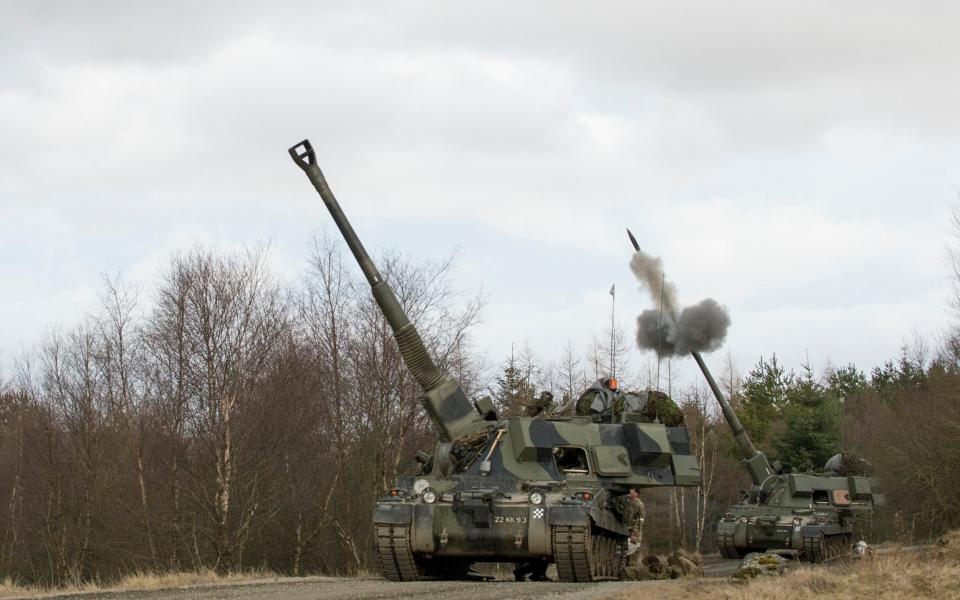Army could rush in new rockets as Ukraine war exposes Britain's 'out of date' artillery

The army could rush new rockets into service after the war in Ukraine has shown Britain's current artillery system is “hopelessly out of date” the Defence Secretary has said.
Ben Wallace said years of campaigning in Iraq and Afghanistan has left the traditional war fighting role of the army “neglected” and in dire need of modernisation.
The war in Ukraine has shown how one of the army’s current artillery systems is “not good enough…short of range” and “outgunned by most of its peer group,” he added.
Plans to introduce new precision rocket systems could be brought forward as a result.
Speaking in Italy on HMS Albion, one of Britain’s amphibious assault ships, Mr Wallace said: “We’re investing 24 billion pounds into the Army's equipment programme (EP) between now and the end of the decade.
“That's a lot of money. Because quite rightly, the army needs to catch up.
“It has been neglected by quite a few people over the last two decades. So it needs to be modernised.
“We need to rapidly look at the lessons of Ukraine because they have actually given us an opportunity to see not only where we're vulnerable but actually have [we] got the balance of investment right within the Army. Are there too many of X and not enough of Y.”

Defence experts say the use of precision-guided long-range artillery has been instrumental in pushing back Russian troops in Ukraine.
In a new paper on the war in Ukraine, defence think tank Rusi says from April, the West “became Ukraine’s strategic depth”, and Kyiv’s troops “only robbed Russia of the initiative once long-range [missiles] brought Russian logistics under threat”.
Defence chiefs have long wanted to retire Britain’s ageing AS-90, a self-propelled artillery gun, which fires 155mm shells, in favour of increased numbers of the M270 multiple launch rocket system.
Britain has gifted six M270 MLRS plus ammunition to Ukraine, from a total of around 40 systems.
Mr Wallace said Britain’s AS-90 artillery system was out of date for the modern battlefield and not capable of providing “deep fires”; military terminology for long-range attacks.
Even taking into account stocks of precise weapons, Mr Wallace said: “we don't have enough deep fires and our deep fires aren't good enough”.
He said the extra money won from the Treasury for the MoD’s equipment plan could allow an earlier retirement date for AS-90.
“The AS-90 replacement programme is in [the EP] and it’s very important.
“If I can bring it forward I will.
“Our AS-90 is hopelessly out of date, short of range and outgunned by most of its peer group.”
He said AS-90 replacement was “one of the main programmes” in the MoD’s equipment plan.
Not all of the additional £24billion is expected to be spent on new kit, The Telegraph understands.
About half will be ring-fenced as a reserve in case existing programmes run over budget, and for research and development projects.
An estimated £6 billion will be used to fill the ‘black hole’ in MoD finances caused by years of equipment overspends.
The remainder will be used for new equipment.
Some has already been allocated to the improvement programme for the RAF Chinook helicopter fleet, a move likely to save the taxpayer millions of pounds.
The £1.4 billion order, announced in May 2021, for the H-47 Extended Range-variant of Chinook had been expected to be delayed after the MoD said it needed to “reconsider the expenditure profile of this project”.
Extending delivery of the first of 14 aircraft by three years to 2030 was expected to cost £300 million, money that will not now be lost as the programme is brought back to its original time scale.
The new helicopters will take the number of Chinooks in RAF service up to 60.

 Yahoo News
Yahoo News 
